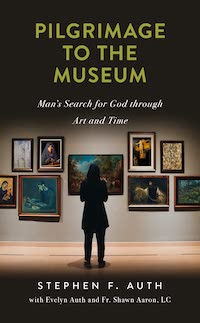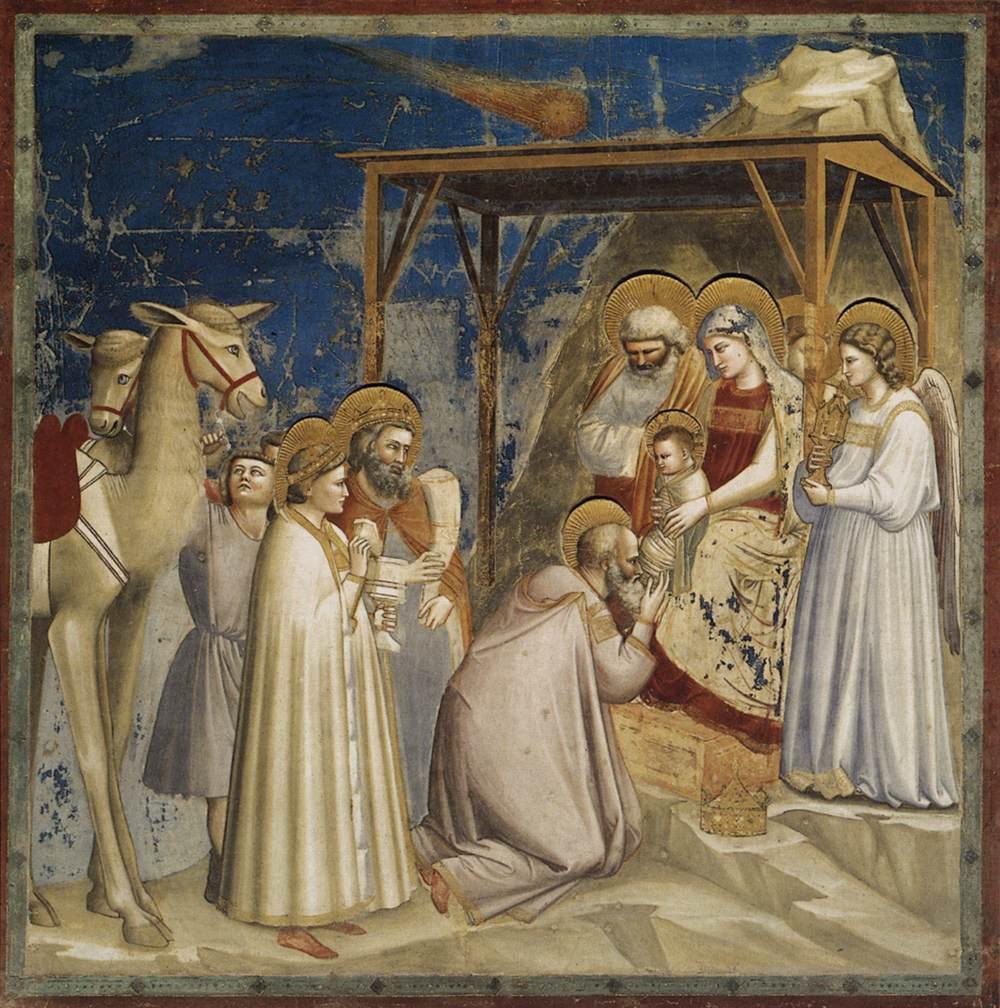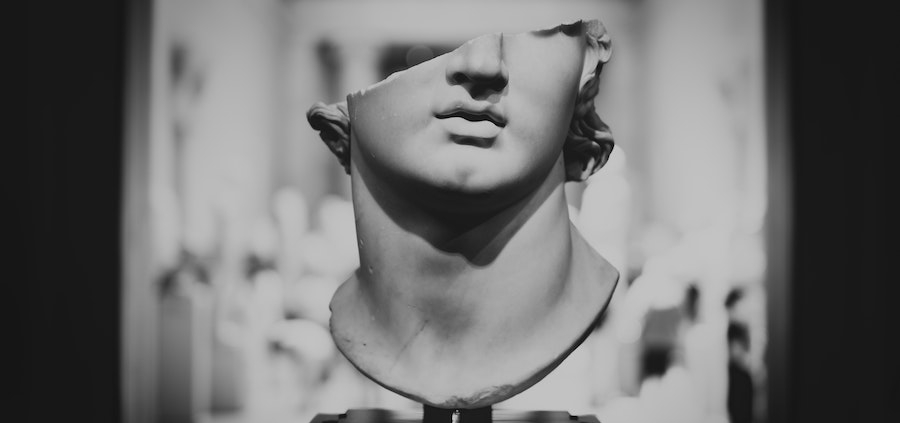Museum Hours by Kathryn Sadakierski

Pilgrimage to the Museum:
Man’s Search for God through Art and Time
By Stephen F. Auth
with Evelyn Auth and Fr. Shawn Aaron, LC
Sophia Institute Press, 2022
$19.95 230 pp.
Standing in a quiet art gallery, walls hung with paintings illuminated by lights like candles shining underneath, it’s natural to get the sense that you are in a sacred place. It’s an experience not unlike being in a cathedral, taking in the majesty of tall pillars and soaring ceilings that call us to look up. Aptly, Stephen F. Auth titles his new memoir-meets-art-history commentary Pilgrimage to the Museum, highlighting the spiritual meaning that a visit to a museum can take on.
As Auth underscores in the volume, the fresh perspective that looking at art affords allows us to more clearly see God at work in our lives. In developing a deeper appreciation for all the layers of emotional depth in art, so, too, is it possible to better love God, appreciating the mystery and complexity of who he is. Further, we come to uncover the nuances of our own identities in Christ as Auth introduces us to masterpieces that aren’t merely past artifacts, but groundbreaking works relevant to today.
Reflecting on his own conversion experience, Auth illustrates how his understandings of Catholic teachings were strengthened through art. Guiding readers through the stories told in paintings and sculptures, Auth demonstrates how art ignites the imagination, magnifying truth from inventive angles that help believers to see the heart of the matter. He also shows how art can plant seeds in nonbelievers, perhaps acting as the initial impetus that stimulates further inquiry into the divine.
Much as pieces of artwork might appear enigmatic (untangling all of those lines on a Jackson Pollock canvas, for one), Auth argues that the puzzles their details present are solved when regarded through eyes of faith: God is the key unlocking what doesn’t make sense on the surface. God leads us and “curates” our lives in the ultimate tour, a pilgrimage to recognize timeless beauty within and without.
Across 12 clean, concise chapters, Auth thoughtfully examines how Western art has evolved over the years, with artists throughout history searching for God in paint and clay, recording their feelings, and capturing the spirit of their times while contributing to a broader, unbroken narrative that points beyond the frame—to eternity, not only fleeting moments. Beyond comparing variances in technical approaches between artists, Auth shows how their knowledge of God, their process of seeking, developed over time, from a worldview centering man as God to glorification of Christ as Savior of humankind.
The connecting point between so many unique expressions of creativity, Auth emphasizes, is not outward similarity in terms of era or theme, but the underlying impulse to witness to the everlasting. Auth draws from a rich palette that will appeal to every palate, from those who relish traditional Renaissance and baroque pieces (the chapters on these periods being among the best of the book), to fans of abstract expressionists like Pollock, but all readers will be challenged to look with open eyes to what God is revealing through his creative messengers.
Starting with Egyptian art (pre-revelation theology), and ending with surrealism (post-revelation theology), Auth maintains a tight focus by structuring Pilgrimage to the Museum around the works collected in one particular setting: New York’s Metropolitan Museum of Art. There are a few notable exceptions, such as Van Gogh’s Starry Night at the Museum of Modern Art, without which a conversation on art would be incomplete, but Auth’s framework, using a chronological timeline that brings us through the adjoining galleries of the museum, prevents the book from becoming overwhelming.
Rather than an exhaustive history of art like Ernst Gombrich’s classic Story of Art, Auth provides an ideal introduction to the study of art history, something of a literary equivalent to John Green’s “Crash Course” history videos. Each chapter conveys overarching ideas by concentrating on a few major artworks, visually underlining the flow of thought about God through time and aiding readers’ comprehension of how art, and the religious views expressed therein, have shaped today’s society. Pilgrimage to the Museum benefits by being written immersively, describing the layout of the Met in such a way that readers are made to feel that they are physically present, walking among the treasures on display. Complementing the text are full-color images of the artworks that allow us to admire their subtler details, envisioning ourselves in the scenes, heightening the sense that this book is a map of the soul and the winding ways it takes to reach God.
Employing a lively, conversational tone, Auth’s gentle humor makes Pilgrimage to the Museum very readable, for art history buffs and others striving for a greater connection with God. He is not just telling the story of the art, but modeling the art of engaging storytelling, sparking a brighter flame of love for Christ. His lighthearted interpretation of Mary and Joseph’s thoughts in Giotto’s nativity painting Adoration of the Magi is one such example:
The lead king kneels before the one true King . . . It seems as if he has spontaneously been inspired to hold the Christ Child himself . . . while Joseph and Mary look on with a bit of anxiety . . . “Careful there, your majesty! Have you ever held a baby before? This one is extremely precious! Right now, goal number one is to keep Him safe so He can complete His mission to save the world!”
As Auth imagines the dialogue of characters in paintings, we, too, are invited to not only step into their headspace and empathize, but to consider our own thoughts and actions as well as how closely they reflect those of Christ. This leads us to consider how we might orient ourselves back towards him when we face distraction and doubt. We are not met with dispassionate explications on art, but deeply felt stories of the people who figure in the works, as well as those artists who rendered them.

Giotto, “Adoration of the Magi,” c. 1306
Pilgrimage at the Museum includes many of these moments when we are ushered in as participants in the action. Auth weaves in affective and analytic responses to art, combining art history with personal history and meditating on how the impact of art on one’s soul can branch out into ever greater blessings: “In the glimmer of this miniature icon from what historians used to call a ‘darker’ era, I am enlightened. I know my place again. And I can see the path home. Through Him. That’s a beginning.”
This path is not a solitary one, however. It is taken as a community. Auth uses a universal approach in asking probing questions for readers to contemplate, and encourages them to relate takeaways from each work to their own experiences. This approach challenges the reader to continue seeking in art, life, and faith, ensuring that they are not spiritually blind to what truly sustains, self-reliant instead of God-reliant.
On the subject of Rembrandt’s The Return of the Prodigal Son (1668), for instance, Auth encourages readers to ask themselves: “When have I been the older son—too proud to ask the Father to forgive me, to love me?” We are reminded that we are one family in Christ, all guiding each other along the journey, collectively feeling the power of art to communicate our innermost hopes, to courageously proclaim what we may have shied away from acknowledging. Times change, but what hasn’t changed is our need for God, a longing for the spiritual fulfillment only he can bring.
What ultimately distinguishes Pilgrimage to the Museum from other volumes on art history is the higher purpose kept at the forefront: we aren’t simply presented colorful factoids about, say, Van Gogh’s ear, or scholarly dissertations about the stylistic choices of artists, but are enlightened as to the ways to glean spiritual wisdom from art both secular and religious, ancient and modern. This treatment allows for the breath of life, inspiration from the Holy Spirit, to be felt running through the veiny brushstrokes of each painting under discussion. Itself a chiaroscuro, the book contrasts darkness and light, departures and returns on the road to Christ by showcasing paintings and sculptures of sinners and saints alike. This counterbalance is used to point us to God, evidencing that holiness is possible for all, so long as one is willing to change, to turn away from sin and pride towards sanctity and humility.
It turns out the gallery was never quiet after all: there were always many voices telling one story of God and his children, as he persists in extending his graces, a hand outstretched in mercy, stirring our souls: “God yearns for each of us,” Auth writes. “There are so many ways in which He reaches out.” Art is one such way, and through taking the time to engage with it, to read the stories it tells, we can learn how to reach back and to use our own talents to continue the story of Christ’s saving mission. ♦
Kathryn Sadakierski’s writing has appeared in Agape Review, DoveTales, Edge of Faith, Ekstasis Magazine, enLIVEN Devotionals, Refresh Bible Study Magazine, and elsewhere. She holds a B.A. and M.S. from Bay Path University. Kathryn is passionate about sharing her love for God through her work, with the goal of making a positive impact.





Leave a Reply
Want to join the discussion?Feel free to contribute!